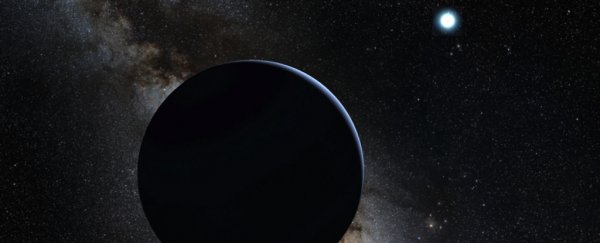It's one of the most intriguing questions about the Solar System from the last five years: Is there a large planet, lurking out in the cold dark reaches, on an orbit so wide it could take 20,000 years to complete?
The answer has proven elusive, but a new study reveals what could be traces of the mysterious hypothetical object's existence.
Astronomer Michael Rowan-Robinson of Imperial College London in the UK conducted an analysis of data collected by the Infrared Astronomical Satellite (IRAS) in 1983, and found a trio of point sources that just might be Planet Nine.
This, Rowan-Robinson concludes in his preprint paper, is actually fairly unlikely to be a real detection, but the possibility does mean that it could be used to model where the planet might be now in order to conduct a more targeted search, in the quest to confirm or rule out its existence.
"Given the poor quality of the IRAS detections, at the very limit of the survey, and in a very difficult part of the sky for far infrared detections, the probability of the candidate being real is not overwhelming," he wrote.
"However, given the great interest of the Planet 9 hypothesis, it would be worthwhile to check whether an object with the proposed parameters and in the region of sky proposed, is inconsistent with the planetary ephemerides."
Speculation about the existence of a hidden planet in the outer reaches of the Solar System has swirled for decades, but it reached a new pitch in 2016 with the publication of a paper proposing new evidence.
Astronomers Mike Brown and Konstantin Batygin of Caltech found that small objects in the outer Solar System's Kuiper Belt were orbiting oddly, as though pushed into a pattern under the gravitational influence of something large.
But finding the dratted thing is a lot more complicated than it might sound. If it is out there, it could be five to 10 times the mass of Earth, orbiting at a distance somewhere between 400 and 800 astronomical units (an astronomical unit is the average distance between Earth and the Sun; Pluto, for context, is around 40 astronomical units from the Sun).
This object is very far away, and quite small and cold and probably not reflecting much sunlight at all; and, moreover, we don't know exactly where in the very large sky it is. So the jury is out on whether it is real or not, and the topic is one of pretty intense and interesting debate.
IRAS operated for 10 months from January 1983, taking a far-infrared survey of 96 percent of the sky. In this wavelength, small, cool objects like Planet Nine might be detectable, so Rowan-Robinson decided to re-analyze the data using parameters consistent with Planet Nine.
Of the around 250,000 point sources detected by the satellite, just three are of interest as a candidate for Planet Nine. In June, July, and September of 1983, the satellite picked out what appears to be an object moving across the sky.
It's not a dead cert, by a long shot. The region of sky in which the source appears is at low galactic latitude (that is, close to the plane of the galaxy), and strongly affected by galactic cirrus, filamentary clouds that glow in far-infrared. So it's possible that the sources are noise from these clouds.
Rowan-Robinson also notes that another highly sensitive survey, Panoramic Survey Telescope and Rapid Response System (Pan-STARRS), in operation since 2008, has failed to recover the candidate.
However, if we interpret the candidate as real, we can extrapolate some information about Planet Nine. According to the IRAS data, it would be between three and five times the mass of Earth, at an orbital distance of around 225 astronomical units.
The motion of the source across the sky also gives us an idea of the potential planet's orbit, telling us where in the sky we could be looking now, and where we can look in other data, such as that from Pan-STARRS.
"Dynamical studies are needed to check whether such an object is consistent with the ephemerides of other Solar System objects and whether this object can account for the clustering of the orbits of Kuiper belt dwarf planets," Rowan-Robinson writes.
"The IRAS detections are not of the highest quality but it would be worth searching at optical and near infrared wavelengths in an annulus of radius 2.5-4 deg centered on the 1983 position. This candidate could be ruled out if radio or other observations confirmed the reality (and stationarity) of the IRAS sources at the 1983 … positions."
The paper is available on preprint server arXiv, and has been accepted for publication in the Monthly Notices of the Royal Astronomical Society.
